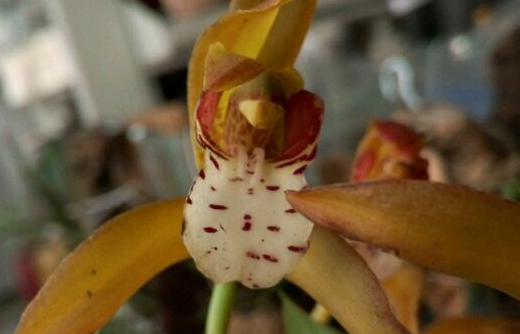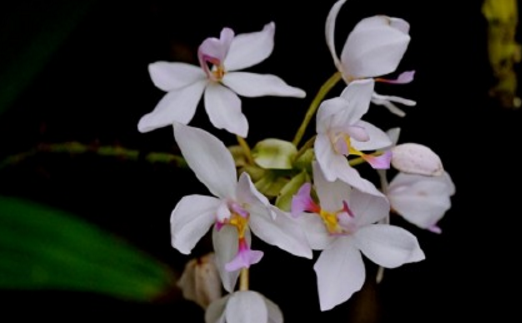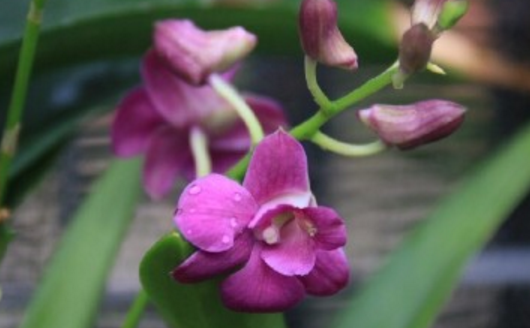What is the culture method of Lilium subclass Magnolia? How do you breed? What about the rotten roots?
The orchid likes the sunny and cool environment, but the high temperature does not grow well, so what is the breeding method of the orchid? How do you breed? What about the rotten roots? It is understood that the orchid should be planted in a well-ventilated environment. Sex likes shade, avoid direct sunlight, like moist, avoid dryness. 15 ℃ ~ 30 ℃ is its comfortable temperature zone and can grow well.

First, what is the culture method of glossy orchid?
Loading basin
The time of putting on the basin (or turning the basin) is usually from March to April in spring. Flowerpots with small mouth, deep pot, large bottom hole is better. The wild seedlings newly dug up from the mountain should be planted in the mud basin, so that the orchid mud is easy to dry, ventilated and easy to root; it can be replaced with purple sand basin or porcelain basin after 2-3 years.
The method of orchid planting (in the pot) is different from the general flowers, especially the famous orchids, the roots must be washed. The method is: soak the root in clean water, wash it gently with an old toothbrush or brush, do not use too much force to prevent damage to the root system, carefully trim the medicine, and then pay attention to the ventilation effect of the environment.
1. Method 1: after preparing the orchid pot and plant, put the orchid plant upside down (root on the top, leaf on the bottom) under the faucet and rinse with slow water, the water pressure should be gentle, so as not to hurt the orchid root and leaf. Grasp the orchid head with your thumb and index finger, hold the little finger against the edge of the basin, and fix the root with bamboo chopsticks. When you put it into the basin, try not to let the root touch the basin wall. Pour the pea-sized mixed gravel into the bottom of the basin to 1/3. Then pull out the bamboo chopsticks and shake the plants in a pot.
two。 Method 2: pay attention to the drainage of the basin bottom, fill the mud basin with broken tiles, and cover the basin bottom with perforated nylon gauze. Before planting, cover the basin with coarse stones, accounting for about 2 to 5 percent of the basin depth, rough stone culture soil, 3-5 centimeters thick, and then put in bluegrass. When putting on the basin, pay attention to the root to self-expand, not curl. When planting a famous species of bluegrass, you must put the old grass aside and the new grass in the center, leaving room for the new grass to be reissued.
Second, how to reproduce?
The main results are as follows: 1. The mode of reproduction: ramet.
It can be carried out in both spring and autumn, usually every three years.
All plants with dense pseudocorms can be ramified, and at least 5 connected pseudocorms should be preserved in each clump.
Irrigation should be reduced before dividing plants to make the basin soil drier. When putting on the basin after ramet, first cover the bottom hole of the basin with broken tiles, then cover with coarse stones, occupy the depth of the basin from 5 to 1, and then put coarse-grained soil and a small amount of fine soil, and then plant it with sandy loam rich in humus.
After the ramet, the planting depth should be 2 cm along the edge of the basin, covered with green cloud grass or fine pebbles, finally watered thoroughly, placed in the shade for 10-15 days, keep the soil moist, gradually reduce watering, and carry out normal maintenance.
2. The mode of reproduction of Magnolia: sowing
The orchid seed is very fine, there is only one underdeveloped embryo in the seed, the germination power is very low, and the seed coat is not easy to absorb water, so it can not germinate by conventional sowing, so it needs to use orchid or artificial medium to supply nutrients in order to germinate. Orchids are not easy to get, but famous products are even more precious!
It is best to sow the uncracked fruit, sterilize the surface with 75% alcohol, take out the seed, soak it with 10% sodium hypochlorite for 5-10 minutes, rinse it with sterile water for 3 times, sow it in a culture bottle containing the culture medium, and then put it in a dark culture room. the temperature is kept at about 25 °, and then moved to the light to form the protocorm. It takes half a year to a year from sowing to transplanting.
Third, what about the rotten roots?
1. Rotten roots of Magnolia: to improve the quality of nutritious soil.
Poor permeability of nutritious soil, poor drainage, overripe or over-ripe soil can easily lead to rotten roots of orchids. At this time, it is necessary to improve the quality of the nutritious soil, enhance the drainage and air permeability in the basin, and improve the soil quality.
2. Adjust the amount of fertilizer and water the right amount.
Magnolia can not be fertilized too much, fertilization should be a small number of times, otherwise excessive fertilizer will produce heat and cause root system to burn and rot. Watering should also be appropriate, too much will make the nutrient soil water content is too large, poor air permeability, root breathing difficulties, resulting in rotting roots.
3. Disinfection treatment, timely diagnosis and treatment
In the maintenance process of orchids should be often observed, found that there is a rotten root phenomenon should be treated immediately.
Take out the plant, remove the rotten root, rinse the root with 1% potassium permanganate water for disinfection, or apply some charcoal powder to the affected area and sun the root in the greenhouse for about 30 minutes. If the rotten root is more than 50% or all rotten, use the above method to treat and then use river sand to promote the root.
The root-promoting temperature should be higher than the normal temperature, which is generally controlled at about 22-30 ℃, so that new roots will grow after about 2 months, and then transplanted to the nutrient soil basin.
Time: 2019-03-16 Click:
- Prev

The breeding methods and precautions of Magnolia mandshurica? How to fertilize? How do you water it?
Cymbidium is a plant of the genus Orchidaceae, so what are the culture methods and matters needing attention? How to fertilize? How do you water it? According to the data, the orchid generally grows on the hillside and ancient walls of deep mountains and valleys, with shade, short sunshine or places where only stars leak light. Sex likes yin and avoids direct sunlight.
- Next

How to grow Lanyako Wandailan? The difference between Qiandailan and Qiandailan? What if the leaves turn yellow?
Wandailan, also known as Wandai orchid, is a southern orchid, so how to grow Wandai orchid? The difference between Qiandailan and Qiandailan? What if the leaves turn yellow? According to the data, Wandailan has strong cold resistance, poor heat resistance, like drying and anorexia, and still grows well in high temperature 35 ℃. Cultivation requires less plant material.
Related
- Fuxing push coffee new agricultural production and marketing class: lack of small-scale processing plants
- Jujube rice field leisure farm deep ploughing Yilan for five years to create a space for organic food and play
- Nongyu Farm-A trial of organic papaya for brave women with advanced technology
- Four points for attention in the prevention and control of diseases and insect pests of edible fungi
- How to add nutrient solution to Edible Fungi
- Is there any good way to control edible fungus mites?
- Open Inoculation Technology of Edible Fungi
- Is there any clever way to use fertilizer for edible fungus in winter?
- What agents are used to kill the pathogens of edible fungi in the mushroom shed?
- Rapid drying of Edible Fungi

